Given that he has been hailed as “Israel’s Walt Disney,” it makes sense that artist, animator, and Holocaust survivor Joseph Bau’s life has been memorialized in multiple films. His clandestine wedding to a fellow inmate in the Płaszów concentration camp was depicted in Schindler’s List, and in September 2025 a feature film based on his life premiered in theaters. Bau: Artist at War, was released in conjunction with the biographical film of the same name, and recounts Bau’s efforts to survive in the Krakow ghetto with his immediate family, his imprisonment in Płaszów, his unlikely reunion with his wife after liberation, and his return to Europe after making aliyah to testify against the SS officer who killed his father.
Bau’s descriptions of life in the ghetto and in Płaszów hit upon familiar, if no less heart-wrenching and vivid, beats: the degrading conditions, the bottomless hunger, the reflexive sadism of the Germans and especially of camp commandant Amon Goeth, whose cruelty was shocking even by Nazi standards. What distinguishes Bau: Artist at War from other survivor memoirs is the sense of irony — and perhaps even humor — that suffuses its narrative. This is a rare Holocaust story that can make one smile and occasionally laugh. The good-natured Bau never fully gives in to bitterness, but even he cannot escape the lasting trauma of his experiences; when, several decades after the war, he and his wife travel to Vienna to testify against his father’s murderer, he suffers a nervous collapse and is hospitalized for weeks. Besides his wife, his only friendly visitor is Oskar Schindler, who saved his life and the life of many other Jews in Płaszów by hiring them to work in his factory.
The highlight of the book is its remarkably detailed, building-by-building tour of Płaszów, accompanied by a map drawn by Bau, who was forced by the Nazis to serve as a graphic designer during his imprisonment. Bau’s striking, black-and-white drawings — sometimes funny, sometimes filled with pathos, but always clever and affecting — pepper the book, as do several of his poems. The book’s text appears to have been extracted from parts of Bau’s 1998 memoir, Dear God, Have You Ever Gone Hungry? As such, it does not tell a complete, linear story but rather chunks of one. At times, its discontinuous structure mirrors the nature of living with trauma, as dark memories interrupt the normal chronologies of life and memory; more often, however, it feels incomplete and a little unsatisfying, as readers must turn to the book’s afterward, forwards, and biographical notes to fill in the gaps and flesh out the story. This front- and backmatter reveal that Bau and his wife, Rebecca, led extraordinary lives, with each saving the lives of fellow Jews during the Holocaust and building successful careers after it. Bau: Artist at War provides profound glimpses of an insightful and important artist during the most important period of his life and will undoubtedly inspire readers to learn more about Bau and seek out more of his artwork.
Meghan Riley earned a PhD in Modern European History from Indiana University. She is a postdoctoral fellow at Northern Arizona University.




